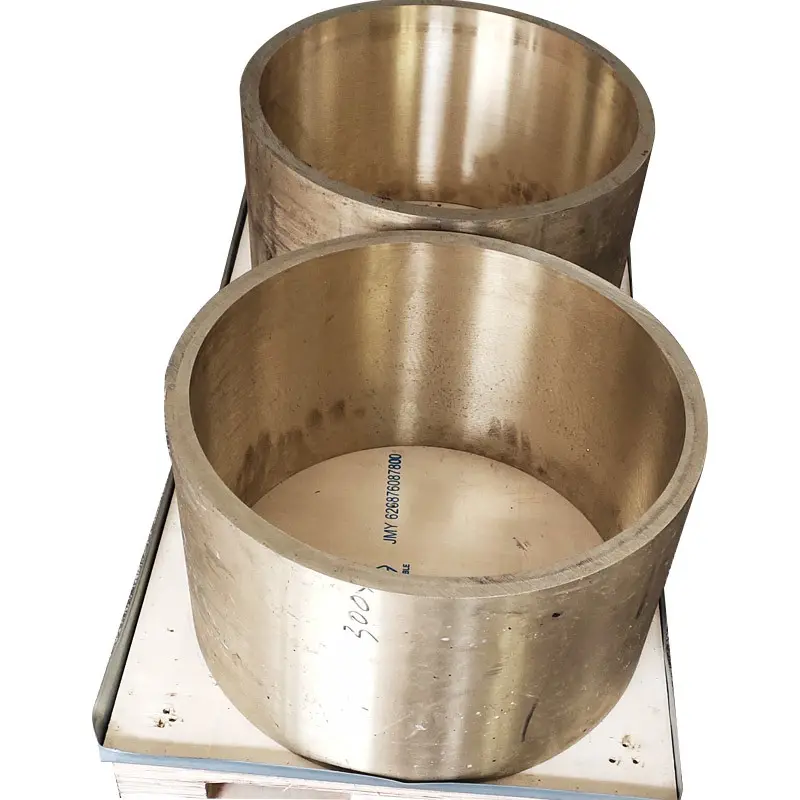
giriiş
Alüminyum bronz borular, olağanüstü güç, korozyon direnci ve dayanıklılık kombinasyonu nedeniyle çeşitli endüstrilerde önemli popülerlik kazanmıştır. Bu kapsamlı kılavuz, mühendisler, tedarik uzmanları ve endüstri profesyonelleri için değerli bilgiler sağlayarak alüminyum bronz boruların özelliklerini, uygulamalarını, üretim süreçlerini ve bakımını araştırmaktadır.
Kompozisyon ve özellikler
Alüminyum bronz borular, birincil alaşım elemanı olarak alüminyum içeren bakır bazlı alaşımlardır. Alüminyum eklenmesi, malzemenin özelliklerini önemli ölçüde arttırır, bu da zorunlu uygulamalar için uygun hale getirir.
Kimyasal bileşim
Alüminyum bronz boruların tipik bileşimi, spesifik dereceye bağlı olarak değişir. İşte borular için kullanılan yaygın alüminyum bronz alaşımların bileşimini gösteren bir tablo:
| Alaşım | Cu (%) | Al (%) | FE (%) | (%) | MN (%) | Diğer (%) |
|---|---|---|---|---|---|---|
| C95200 | 86-89 | 8.5-9.5 | 2.5-4.0 | – | – | 00,25 maksimum |
| C95400 | 85-89 | 10-11.5 | 3.0-5.0 | – | 00,5 maksimum | 00,25 maksimum |
| C95500 | 78-82 | 10-11.5 | 3.5-4.5 | 4.0-5.0 | 00,5 maksimum | 00,25 maksimum |
| C95800 | 79-82 | 8.5-9.5 | 3.5-4.5 | 4.0-5.0 | 00,8-1,5 | 00,25 maksimum |
Anahtar Özellikler
Alüminyum bronz borular, onları çeşitli uygulamalar için ideal hale getiren benzersiz bir özellik seti sunar:
- Korozyon Direnci: Deniz suyuna, acı suya ve birçok kimyasala karşı mükemmel direnç.
- Yüksek güç: Standart bakır alaşımlarına kıyasla üstün mukavemet.
- Aşınma direnci: Aşınma ve erozyona karşı iyi direnç.
- Termal iletkenlik: Orta termal iletkenlik, paslanmaz çelikten daha iyi.
- Kıvılcım çıkarmayan: Patlayıcı ortamlarda kullanım için uygundur.
- Biyo -kaldırma direnci: Deniz büyümesine doğal olarak dirençli.
Uygulamalar
Alüminyum bronz borular, benzersiz özellikleri nedeniyle çeşitli endüstrilerde uygulamalar bulur. İşte temel uygulamaları özetleyen bir tablo:
| Endüstri | Uygulamalar |
|---|---|
| Deniz | Deniz suyu boru sistemleri, pervane şaftları, pompa muhafazaları |
| Oil & Gas | Açık deniz platformları, denizaltı ekipmanı, valf gövdeleri |
| Kimyasal İşleme | Isı eşanjörleri, reaksiyon gemileri, damıtma sütunları |
| Güç üretimi | Kondens tüpleri, soğutma su sistemleri, valf bileşenleri |
| Havacılık | Hidrolik sistemler, iniş dişlisi bileşenleri |
| madencilik | Bulamaç boru hatları, pompa bileşenleri, tarama ekipmanı |
Vaka çalışması: Deniz suyu soğutma sistemleri
Dikkate değer bir uygulamada, bir kıyı enerji santrali paslanmaz çelik deniz suyu soğutma borularını C95800 alüminyum bronz borularla değiştirdi. Sonuçlar etkileyiciydi:
- Bakım maliyetlerinde% 40 azalma
- Isı transfer verimliliğinde% 25 artış
- 15 ila 25 yıl arasında genişletilmiş sistem ömrü
Üretim süreçleri
Alüminyum bronz borular, belirli gereksinimleri karşılamak için çeşitli işlemler kullanılarak üretilir:
- Savurma döküm: Mükemmel boyutlu doğruluğa sahip büyük çaplı borular için idealdir.
- Ekstrüzyon: Tutarlı duvar kalınlığına sahip daha küçük çaplı borular için uygundur.
- Sürekli döküm: Standart boyutlarda yüksek hacimli üretim için verimli.
- Kaynaklı imalat: Özel uygulamalar için özel şekiller ve boyutlar.
Kalite kontrol önlemleri
En yüksek kaliteyi sağlamak için üreticiler titiz kalite kontrol önlemleri uygular:
- Ultrasonik test ve radyografi gibi tahribatsız test (NDT) yöntemleri
- Spektrometri kullanılarak kimyasal bileşim analizi
- Çekme mukavemeti ve sertlik testleri dahil mekanik özellik testi
- Boyutsal denetimler ve tolerans kontrolleri
Seçim kılavuzu
Uygulamanız için doğru alüminyum bronz boru seçmek çeşitli faktörleri dikkate almayı içerir:
- Çalışma ortamı: Sıcaklık, basınç ve kimyasal maruziyet gibi faktörleri düşünün.
- Mekanik Gereksinimler: Güç, sertliği ve aşınma direnci ihtiyaçlarını değerlendirin.
- Korozyon Direnci: Uygulamada bulunan belirli aşındırıcı ajanları değerlendirin.
- Maliyet Hususları: Başlangıç maliyetlerini uzun vadeli performans ve bakım tasarrufu ile dengeleyin.
Diğer malzemelerle karşılaştırma
İşte alüminyum bronz boruların diğer yaygın boru malzemeleriyle karşılaştırma tablosu:
| Mülk | Alüminyum Bronz | Paslanmaz çelik | Karbon Çelik | Bakır nikel |
|---|---|---|---|---|
| Korozyon Direnci | Harika | İyi | Fakir | Çok güzel |
| Kuvvet | Yüksek | Yüksek | Ilıman | Ilıman |
| Maliyet | Yüksek | Ilıman | Düşük | Ilıman |
| Ağırlık | Ilıman | Yüksek | Yüksek | Ilıman |
| Termal iletkenlik | Ilıman | Düşük | Yüksek | Ilıman |
| Biyo -kaldırma direnci | Harika | Fakir | Fakir | İyi |
Kurulum ve Bakım
Alüminyum bronz boruların performansını ve ömrünü en üst düzeye çıkarmak için uygun kurulum ve bakım çok önemlidir:
Kurulum En İyi Uygulamalar
- Galvanik korozyonu önlemek için uyumlu bağlantı parçaları ve contalar kullanın.
- Borular üzerindeki stresi en aza indirmek için uygun destek ve demirleme uygulayın.
- Birleştirme gerekiyorsa önerilen kaynak prosedürlerini izleyin.
- Devreye girmeden önce kapsamlı bir yıkama ve temizlik yapın.
Bakım İpuçları
- Aşınma veya korozyon belirtileri için düzenli denetimler
- Deniz büyümesini veya ölçek birikimini kaldırmak için uygun temizlik
- Batık uygulamalar için katodik koruma sistemleri
- Soğutma sistemlerinde su kimyasının izlenmesi
Gelecek Eğilimler
Alüminyum bronz boru endüstrisi yeni trendler ve yeniliklerle gelişiyor:
- Gelişmiş alaşımlar: Geliştirilmiş özelliklere sahip yeni alüminyum bronz kompozisyonların geliştirilmesi.
- Katkı maddesi üretimi: Karmaşık boru geometrileri için 3D baskı tekniklerinin araştırılması.
- Akıllı boru sistemleri: Gerçek zamanlı izleme ve öngörücü bakım için sensörlerin entegrasyonu.
- Sürdürülebilir Üretim: Geri dönüşüm ve çevre dostu üretim süreçlerine odaklanın.
Çözüm
Alüminyum bronz borular, çeşitli endüstrilerdeki zorlu uygulamalar için ideal hale getiren zorlayıcı bir özellik kombinasyonu sunar. Özelliklerini, üretim süreçlerini ve seçim kriterlerini anlayarak, mühendisler ve tedarik uzmanları, boru sistemlerindeki performansı ve maliyet etkinliğini optimize etmek için bilinçli kararlar verebilir.
Endüstri gelişmeye devam ettikçe, alüminyum bronz boruların, özellikle aşındırıcı ve yüksek stresli ortamlarda, modern endüstriyel uygulamaların taleplerini ele almada giderek daha önemli bir rol oynaması muhtemeldir.
